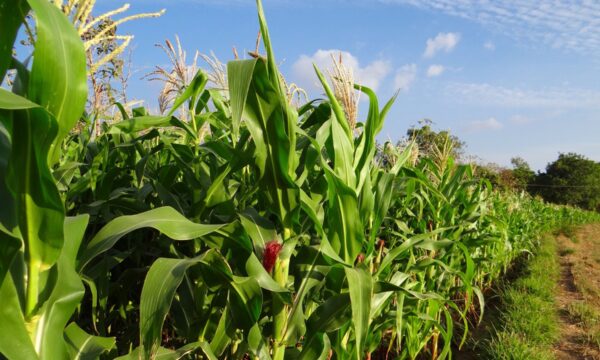A loud booming voice on a megaphone breaks the silence in the farming village of Kaptum centre..”Akwaa! lo mite kapurto nyepo ceyec cepo nyepokaptisyet!”, (come attend a plant health rally by ministry of agriculture officials). Farmers quickly gather and listen attentively as Ministry of Agriculture, Animal Industry and Fisheries (MAAIF) officials conduct the plant health rally.After the rally, we meet Betty Seyekwo, a hardworking farmer and mother of seven children living in Kapchorwa-Uganda. Last season, she planted beans in her 2 acre farm and harvested 13 bags. This was a decline from the previous season when she harvested 20 bags. Before changing crops to beans, Betty was predominantly a maize farmer until a strange disease wiped out her entire crop.
- Betty Seyekwo (right) confers with a colleague during the plant health rally
- Betty Seyekwo studies a pesticide malpractice poster after the plant health rally
- Farmer interviews being conducted after the plant health rally
- Betty Seyekwo studies a MLND poster
“I used to grow an average of 25 kilograms of hybrid maize seeds each season and harvest about 50 bags of maize. Last year I only harvested 10 bags of maize after my plants stopped growing and dried”, says Betty. She adds, “This season, I noticed the leaves of my beans turning yellow and drying especially during the rainy season”.
As a result of the decline in yield, she was unable to comfortably feed her family and had to buy extra food. It was also difficult paying school fees for her children.
“ I was sad that the chemicals I bought and sprayed on my maize and beans did not help save them. The loss was even more when I added up all the resources I spent on fertilizers, weeding, harvesting and transportation to the market. But this is in the past, I now know better”, says Betty. She adds “My mistake was buying and applying the wrong chemicals. I learnt that we have to buy only government registered chemicals that are packed in properly labelled containers. I now know that some chemicals can only be applied before or after the crop is infected. The strange disease that attacked my maize [pointing at the MLND factsheet] is easily managed by crop rotation”.
At the plant health rally, MAAIF district extension staff sensitized farmers with key knowledge on the safe use and handling of pesticides as well as identifying and managing the Maize Lethal Necrotic Disease (MLND). Use of clean certified seed and crop rotation were some of the management methods recommended for managing MLND. Mr Benius Tukahirwa the Agricultural Inspector at MAAIF emphasized that the government is fully committed to helping farmers manage losses to crop pests and diseases.
“Plant health rallies are one of the approaches we are implementing within the Plantwise initiative to complement plant clinics in reaching out to more farmers at the district level. Out of the 88 districts across the country, 70% have plant clinics included in their planning and budgeting”, said Benius. Kaptum centre in Kapchorwa sits at an altitude of 2095 metres above sea level in eastern Uganda and has approximately 6,500 farming households. The top crops grown include maize, irish potatoes, beans, bananas and cabbages.
“I will share this useful knowledge with my husband who is in the farm weeding and my five neighbours so that we all benefit. My health and yield will improve”, says Betty as she departs.
1 Comment
Leave a Reply
Related News & Blogs
How plant clinics are strengthening crop health services in Bangladesh
When the first-ever plant clinic in Bangladesh opened in Dhaka in 2013, it initially faced a lack of interest due to its novelty and limited awareness among farmers. However, it went on to expand, providing advice to over 17,000 farmers and led to the…
2 July 2025









I wish the service should extend to Nigeria,it would have save farmers from yearly losses. Caterpillars affect a lot of farm this year, which might eventually reduced the maize production. I want to be more enlighten and become a plant doctor here in Nigeria.